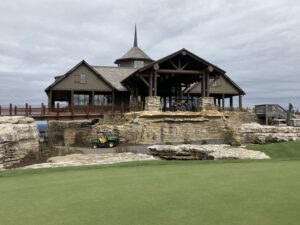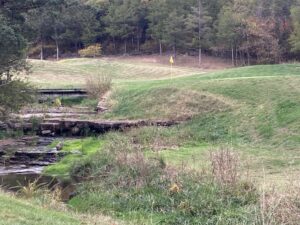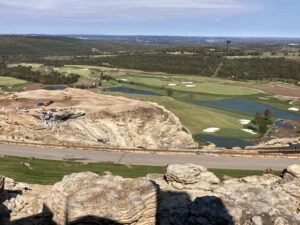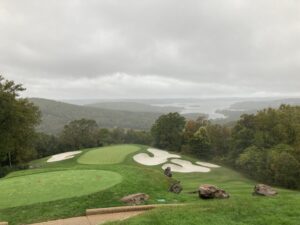By John Brasier
For decades known best for hillbilly theme park Silver Dollar City, country music theaters, bass fishing and as the home of “The Beverly Hillbillies,” Branson has a new upscale vibe, thanks in large part, to Johnny Morris, the founder of Bass Pro Shops.
A regional family and fishing destination in the Ozark Mountains of Southwest Missouri, Branson has transformed itself in the past two decades. World-class golf courses and fine restaurants have joined the list of entertainment options while a variety of luxury accommodations have joined the familiar contingent of roadside motels.
Morris’ Big Cedar Lodge is the Ozarks’ answer to Bandon Dunes and Destination Kohler, featuring spectacular array of varied courses from the likes of Tom Fazio, Bill Coore and Ben Crenshaw, Tiger Woods, Jack Nicklaus and Gary Player. Yet the beauty of the Ozark Mountains (mostly hills), Table Rock Lake and Morris’ ability to mix the best in the golf with a natural, rustic feel, makes it truly unique.
From Nicklaus’ “Top of the Rock” course, the only par-3 layout to host a PGA Tour (Champions) event, to Woods’ “Payne’s Valley,” a tribute to Ozarks native Payne Stewart, Big Cedar courses offers the best in design, scenery and quality conditions with amenities that could only come from the vision of Morris, remarkably a non-golfer.
Payne’s Valley, which created an international buzz with its opening in fall 2020, offers two unforgettable Morris experiences – after the official 18-hole round is over. Despite the wild, natural feel, the courses are immaculately manicured from tee box to greens.
From the 18th green, golfers go to the 19th hole, an island par-3 draped by a background of waterfalls and cave formations. From there, it’s on to twisting, uphill climb of almost one-half mile along a narrow path through cave formations that took Morris several years to create.
The final destination is a mountain top clubhouse and restaurant offering a panoramic view down on the course.
Believe it or not, many golf aficionados rank Payne’s Valley third among Big Cedar’s three 18-hole courses.

Buffalo Ridge Springs, designed by Tom Fazio, is the oldest course at Big Cedar, and set the bar high for its sister courses.
At Osage National, Coore and Crenshaw routed their layout almost entirely along plateaus, giving the players the feeling of playing their entire round perched over glorious unspoiled scenery below,. opened in 2019, and Fazio’s Buffalo Ridge, you’ll understand why designed by the acclaimed naturalist duo of Bill Coore and Ben Crenshaw, where all the holes stretch along the top of mountain ridges.
As always, Coore and Crenshaw provide a natural, classic layout with no surprises. Yet the 7,036-yard, par-71 layout has plenty of teeth with a 73.9 rating and a 131 slope. In the clubhouse Mountain Top Grill and Tall Tales Bar & Grill are open until 9 p.m.
Buffalo Ridge, designed by Tom Fazio and opened in 1999 under different ownership, features dramatic elevation changes and a variety of natural rock formations, waterfalls, caves, lakes and creeks. Ranked as Missouri’s top golf course by Golf Magazine before Morris bought it in 2013, Buffalo Ridge launched Big Cedar’s emergence as a luxury golf destination.

From the clubhouse shared by Ozarks National, players can look down at Payne’s Valley.
Ozarks National and Buffalo Ridge share a clubhouse, where Mountain Top Grill and Tall Tales Bar & Grill are open until 9 p.m.
Generations unfamiliar with the thigh-slapping exploits of Jed, Jethro, Granny and Ellie Mae probably have limited, at best, knowledge of Branson, Missouri, an Ozark Mountain tourism haven known for decades mostly for bass fishing, glassblowing and yes, the hometown of the Clampetts in “The Beverly Hillbillies.”
OK, avid bass fishermen and Baby Boomers taking bus pilgrimages to watch the glassblowers and blacksmiths at Branson’s Silver Dollar City theme park, or performances from Yakov Smirnov (“What a country!”) and Dolly Parton at their personal “theaters,” also know all about this remote spot where the local college puts students to work on the school farm in lieu of charging tuition.
But until the past decade, Branson wasn’t on the radar of many golfers outside of Southwest Missouri and neighboring Northwest Arkansas.
What was Branson? Think Gatlinburg with two fishing lakes rather than Smoky Mountain National Park. No big surprise considering Silver Dollar City and Dollywood are owned by the same family. The two destinations have many of same attractions from aquariums and water parks to family “museums” and outlet stores. Both are historically budget-friendly, family vacation spots.
Thanks largely to Morris, times have changed in Branson, which has the taken a lead in golf. Morris, who grew up less than an hour away in Springfield, Mo., where he sold his original merchandise in one of his father’s liquor stores, is the main force is adding world-class golf to Branson’s traditional lure of fishing and family entertainment.
On and off the luxury 4,600-acre, rustic Big Cedar Lodge resort he developed, Morris has supported the upscale golf boom by opening a wide range of top-flight accommodations and restaurants, making the area the premier spot for mountain resort golf golf west of the Rockies.
The nation’s top golf publications provide written support for that claim. For example, Branson area courses fill the top three spots – and four of the top seven – in Golfweek’s current rankings of public-access courses in Missouri. In 2021, Golf Digest’s ranked a fourth, Payne’s Valley, as its top new public-access course.
The top two are at Big Cedar, where other amenities include a variety of outdoor activities, a spa and two marinas.
For now, the top golf attraction is Osage National, designed by the acclaimed naturalist duo of Bill Coore and Ben Crenshaw, where all the holes stretch along the top of mountain ridges. No. 1 on the Missouri Golfweek resort list, Osage National opened in 2019.
At No. 2, is Buffalo Ridge Springs, a scenic Tom Fazio design featuring dramatic elevation changes and a variety of natural rock formations, waterfalls, caves, lakes and creeks. Opened in 1999 as Branson Creek, and purchased by Morris in 2013, Buffalo Ridge launched Big Cedar’s drive to become a full-scale golf destination.

Branson Hills, designed by Chuck Smith with former PGA Tour pro Bobby Clampett, features a collection of unique rock formations, forests, creeks, waterfalls and other challenges.
No. 3 is Branson Hills, which winds naturally through hilly terrain with less opulence than its Big Cedar neighbors, though blessed with local beauty and an assortment of unique and challenging holes. Designed by Chuck Smith with former PGA Tour player Bobby Clampett (no kin to Jed), Branson Hills was initially named Payne Stewart Golf Club, in recognition of the late PGA Tour star who grew up in Springfield, until a licensing agreement expired in 2015.
Stewart’s name is now attached to Payne’s Valley, which opened too soon to make the Golfweek resort rankings list.
Though Payne’s Valley may not attract as much acclaim from critics as its Big Cedar brothers, it has enough bells and whistles to make it a tourist favorite and a top 10 list regular (Golf Digest ranked it as the nation’s best new public course in 2021).

The clubhouse offers a panoramic view of Payne’s Valley as crews work on a future par-3 layout.
From hiring Woods’ design team to creating the island par-3 19th, followed by the spectacular cart trek though a natural, spring-fed cavern system with bridges over cliff faces traveling through waterfalls up to the mountaintop clubhouse, Morris made his vision for Payne’s Valley a personal priority over several years. But as much noise as his courses have created, Morris tries to maintain a low personal profile, refusing many media requests.
This spring, it was announced that Big Cedar is adding a par-3 course to Payne’s Valley, though many of the details have not been revealed.
Beginning with a spectacular nine-hole, par-3 layout (the first par-3 course included in a PGA (Champions) Tour-sponsored tournament) designed by Jack Nicklaus and opened in 1996, Morris added a collective of golf and non-golf attractions at Big Cedar’s Top of the Rock.
Ozark National and Payne’s Valley share a spacious, mountaintop clubhouse with restaurants and panoramic views of the surrounding courses. Nearby is Mountain Top, a 13-hole short course designed by Gary Player that’s intended for walking and enjoying the Ozark vistas. Tom Watson designed a special putting course.

Table Rock Lake can be seen in the distance on a cloudy day from a tee at Top of the Rock, the Jack Nicklaus par-3 layout.
Non-golf attractions at Top of the Rock include an impressive Ancient Ozark Natural History Museum next to an “infinity pool with an “End of the Trail” sculpture of a weary Native American slumped on horseback.
A short stroll away are “Arnie’s Barn,” a 150-year-old structure moved from Arnold Palmer’s Latrobe, Pennsylvania, hometown to house a restaurant serving the legendary golfer’s favorite mix of Tex-Mex cuisine; a four-story cave with a waterfall; a wedding chapel with a cliffside perch; a Civil War-era cabin built by Amish craftsmen; and assorted memorabilia contributed by Nicklaus, Palmer and Player as well as other celebrities.
While Big Cedar has great golf, luxury accommodations and a wide range of dining, Branson has much more to offer outside Morris’ refuge.
Another Clark design, Ledgestone, part of the lakefront Stonebridge Village resort, ranks No. 7 on the Golfweek list. Though no longer the brightest star in Branson golf, Ledgestone has the same natural mix of elevation changes, water and forest, as well as meticulous playing conditions, to nicely round out any Branson golf trip.
How expensive is Branson golf? Not cheap, but not Pebble Beach or Pinehurst pricey, either.
Fall rates at Ozarks National start at $250. Buffalo Ridge and Payne’s Valley start at $175. Top of the Rock starts at $150. The cheapest — and healthiest – Big Cedar option is the $65 rate for Mountaintop, the 13-hole walking course designed by Gary Player. Rates at Branson Hills range from $109 to $159. Ledgestone fees range from $99 to $109.
Though top lakeside and luxury hotels can cost more than $300 during the peak fall season, many major brand hotel rooms are priced around $100 during the fall.
How do you get to Branson? It’s not that hard, thanks in large part to expansion of Springfield Municipal Airport, which was renamed Springfield-Branson National Airport in 2006 to recognize Branson’s impact in flight volume. Major carriers American, Delta and United as well as Allegiant Air each offers flights.
By road, Branson is about two hours south of Kansas City or about four hours southwest of St. Louis, via Interstate 44 (historic Route 66) and U.S. 65. According to Branson tourism officials, the bulk of the region’s visitors come from a 300-mile radius that includes Dallas-Fort Worth, and major sections of Oklahoma, Kansas and Arkansas, but is expanding with golf traffic via the airport.
Boosted by Morris’ investment, downtown Branson, which sits along the small dammed section of the White River (Lake Taneycomo), now includes two modern Hilton hotels with a convention center. Along the lake, is Branson Landing, a shopping venue with a variety of national and regional retailers, including a Bass Pro Shop, and several restaurants and bars, including eateries from Paula Deen and Guy Fieri.
Much like the Sevierville/Pigeon Forge/Gatlinburg, Tennessee area, the Greater Branson commercial strip includes various family tourism attractions as well as music theaters and chain and local restaurants. The retail options include Tanger Outlets.

















